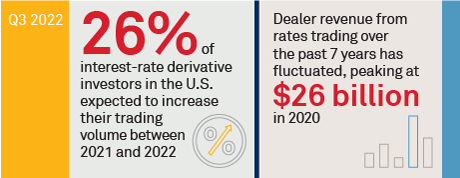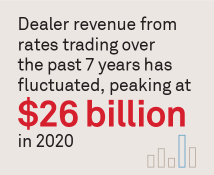
There have been numerous macro trends affecting the interest-rates derivatives (IRD) market: Libor retirement, central bank actions on rates, infation, and the trend toward clearing, to name but a few. These trends have not changed one consistent attribute of IRDs—they are the largest derivatives asset class, representing approximately 80% of the overall derivatives market, according to the Bank for International Settlements (BIS). While this has been the case for some time, trading behavior evolves, and how trades are executed, who acts as counterparties, sell-side revenues from swaps trading, and strategic priorities fuctuate as well.
In particular, a review of volumes and the state of the dealers helps monitor the health of IRD trading, which ebbs and fows with headlines and other changes to the market. Dealers are responding to these changes in many ways, including a strong emphasis on managing capital in support of the trading business as the industry responds to G-SIB assessments, leverage ratios and other requirements. Maximizing revenues in a capital-sensitive way can be diffcult, especially when revenues fuctuate, resulting in an emphasis on optimizing collateral, capital and counterparty exposures.
MethodologyIn Q2 and Q3 2021, Coalition Greenwich interviewed 54 U.S.-based interest-rate derivatives traders on the buy side. Respondents were asked a series of qualitative and quantitative questions to better understand their trading activity, use of e-trading and the dealers they use. In addition, this paper utilizes Coalition Greenwich Competitor Research, which analyzes the revenues and costs of broker-dealers on a quarterly basis.

